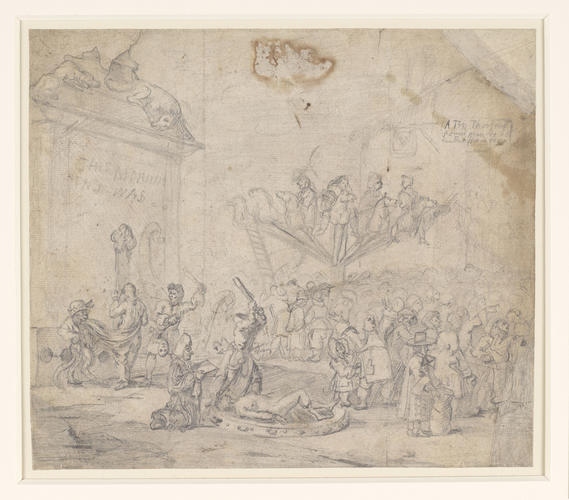-
1 of 253523 objects
A study for The South Sea Bubble 1721
Pencil, incised with stylus | 21.6 x 24.7 cm (sheet of paper) | RCIN 913479

William Hogarth (1697-1764)
A study for The South Sea Bubble 1721
-
A pencil drawing, rubbed and stained, showing a scene outside the Guildhall, with crowds surrounding a nude figure strapped to a wheel, and riders on a merry-go-round at the centre. Incised in places with the stylus. Sheet with torn corners and trimmed to the right.
This preparatory drawing is for William Hogarth's print The South Sea Bubble, published in 1721. The print is a vicious satire of the folly of those who participated in the South Sea scheme in the autumn and winter of 1720-21. A financial bubble, followed by a crash, was caused by investors and brokers who speculated large amounts in risky ventures. After the collapse of the markets at the end of 1720, a number of satirical prints were issued, most notably Bernard Picart's A Monument dedicated to Posterity, which Hogarth would have known in London. Hogarth's print shows the naked and degraded allegorical figures of Fortune, Honour and Honesty. Fortune is being flayed by a devil, with chunks of her flesh being thrown to the crowd. Honesty is strapped to a wheel and battered by the figure of Self-Interest, while Honour faces a plinth and is flayed by the two-faced Villainy. Other figures include a corrupt ape, who is stealing Honour's robe. At the centre of the print is an allegorical merry-go-round of speculation, and on a balcony in the background, a queue has formed for a raffle of lottery-winning husbands.
The preparatory drawing differs in a few small ways from the final print. The figure of Fortune, is not visible on the right, and has probably been trimmed off. The inscription above the raffle queue reads 'a ten thousand pound man to be raffled for'. The trio of gambling Catholic, Jewish and Puritan clerics is not present in this drawing, and neither is the exhausted figure of Trade who appears in the foreground of the print.Provenance
Coll. Standly (sale 1845, lot 1250; Colnaghi (bought 17s); acquired by Queen Victoria
-
Medium and techniques
Pencil, incised with stylus
Measurements
21.6 x 24.7 cm (sheet of paper)
Object type(s)
Other number(s)
RL 13479